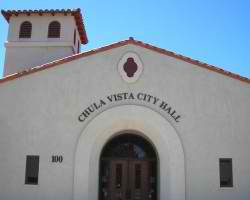The next time you call 911 for a medical emergency or because your home is engulfed in flames, expect the Chula Vista Fire Department to run behind schedule.
The Growth Management Oversight Committee, which annually reviews the city’s general plan regarding development issues, calls for a seven-minute response time for 80 percent of the Chula Vista Fire Department’s calls for service.
But the last time that was met was in 2010.
Darrell Roberts, president of the Chula Vista firefighters union, finds it troubling that the department continues to not meet their response times.
“We’re failing to get to people in time, and this is five years in a row,” he said. “And we’re not comfortable with it.
When seconds matter, it’s a huge problem.”
Data compiled by the GMOC shows that during fiscal year 2015 firefighters responded to 12,561 calls, only 78.3 percent of those were responded to within seven minutes. For fiscal year 2014 there were 11,721 calls for service with 76.5 percent responded to within the GMOC’s standard.
In fiscal year 2013, only 75.7 percent of the 12,361 emergency and medical response calls met the seven-minute threshold.
There were 11,132 calls with only 76.4 percent of the calls meeting their response times in fiscal year 2012. And in fiscal year 2011, firefighters responded to 9,916 calls, and just below the GMOC standard at 78.1 percent.
The last time that threshold was met was in 2010 when 10,296 calls for service were responded to and reached and passed the seven-minute mark 85 percent of the time.
A response time has three components: dispatch time, turn-out time, and travel time.
Dispatch time is the time it takes dispatch to answer a call, gather information, and send it out to firefighters. Turn-out time is when fire personnel is notified about a call and are actively responding to a call. Then there is the travel time, the total time on the road it takes a crew to respond to the scene.
Deputy Fire Chief Harry Muns said the department has taken several measures to improve their time. He said dispatchers have worked on cutting their dispatch time to one minute. Muns said firefighters have also been working to get their times down by getting out the door faster.
Fire Chief Jim Geering said ideally he wants his department to operate at the five minute National Standard for Fire Departments but said his department is doing the best it can to arrive to a scene on time.
“The job is getting done, we’re responding with accuracy,” he said. “We’re doing the best we can with the equipment that we have and the personnel and training. I think we do a remarkable job.”
Geering admits the department can do better in meeting response times, but said he has not heard complaints from the public about not meeting response times or about the services the department delivers.
In its annual report presented to the city council last week, GMOC chairwoman Armida Torres said the issue of not meeting response time is worse in eastern Chula Vista.
“It is also important to note that response times on the west side of the city consistently comply with the threshold standard, while response times on the city’s eastside do not,” the report states. “The GMOC wonders if citizens in eastern Chula Vista would find it acceptable to wait until build-out for their emergency calls to be responded to by the fire department within the Growth Management program’s response time threshold standard.”
Roberts said not meeting response times also has to do with inadequate staffing levels and the lack of fire stations within the city.
According to the 2010 Census, the population in the city of Chula Vista was 243,916. The number of firefighters employed by the city is 118, which puts 49 firefighters per capita below staffing levels.
Roberts said adding additional fire personnel or fire stations will be the best solution in making sure response times are met City Manager Gary Halbert said there is no money in the $294 million budget to add more fire personnel, apparatuses or fire engines.
Roberts, a 15-year veteran of the department, said it is not that the city does not have money in its budget; it is that the city does not want to prioritize their budget for public safety.
The fire department operates with a $27 million budget. Ninety percent of their budget goes towards payroll with the remaining 10 percent splitting up amongst the fire prevention division, fire training, services supplies, and station maintenance, Geering said.
Roberts said the average budget for a department the same size of Chula Vista’s is $44 million.
Chula Vista Mayor Mary Casillas Salas said a potential half-cent sales tax increase that will appear on the Nov. 7 ballot could help firefighters meet response times. Revenue collected from a half-cent sales tax increase is said to be used for repairing the city’s depleting infrastructure. Forty percent of that revenue would go towards funding needs in public safety.
“We would hope that it would [trim response times] because if the voters approve this one of the goals is to upgrade computer dispatch center and fund apparatuses that the department need,” she said. “Hopefully the improvements of having better fire engines, better computer dispatch system would assist our fire department in decreasing their time.”
Casillas Salas said not meeting response times is “always a concern” and that the GMOC gave the city council a very “sobering report.”
She also said that traffic is to blame for not meeting response times, noting that cars are not getting out of the way fast enough when an emergency vehicle is on its way to an emergency.
Roberts said he does not want to get to a point where someone loses their life because firefighters did not get to an emergency on time.
“Seconds are mattering so when we show up two minutes later than a seven minute time, we can be ultimately talking about the difference between life and death,” he said.












